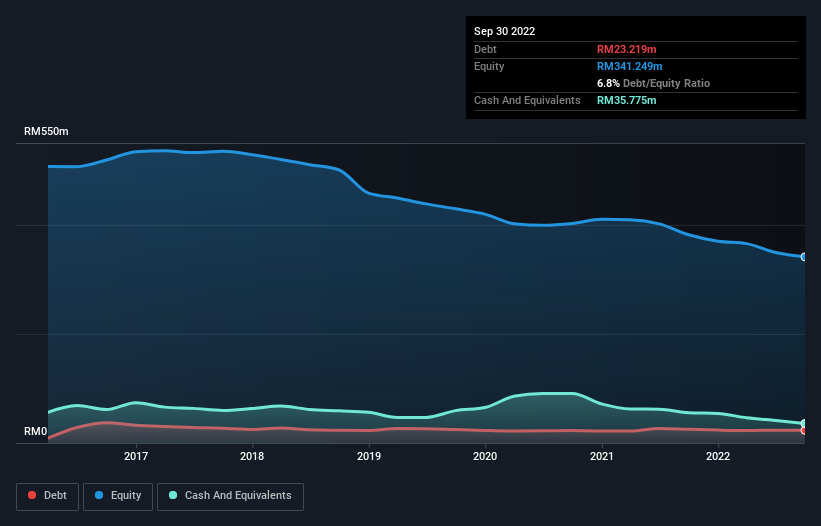Is Kim Hin Industry Berhad (KLSE:KIMHIN) Using Debt Sensibly?

David Iben put it well when he said, 'Volatility is not a risk we care about. What we care about is avoiding the permanent loss of capital.' When we think about how risky a company is, we always like to look at its use of debt, since debt overload can lead to ruin. We note that Kim Hin Industry Berhad (KLSE:KIMHIN) does have debt on its balance sheet. But should shareholders be worried about its use of debt?
When Is Debt A Problem?
Debt and other liabilities become risky for a business when it cannot easily fulfill those obligations, either with free cash flow or by raising capital at an attractive price. In the worst case scenario, a company can go bankrupt if it cannot pay its creditors. While that is not too common, we often do see indebted companies permanently diluting shareholders because lenders force them to raise capital at a distressed price. Of course, debt can be an important tool in businesses, particularly capital heavy businesses. The first thing to do when considering how much debt a business uses is to look at its cash and debt together.
Check out our latest analysis for Kim Hin Industry Berhad
What Is Kim Hin Industry Berhad's Debt?
As you can see below, Kim Hin Industry Berhad had RM23.2m of debt at September 2022, down from RM25.0m a year prior. However, its balance sheet shows it holds RM35.8m in cash, so it actually has RM12.6m net cash.

How Healthy Is Kim Hin Industry Berhad's Balance Sheet?
The latest balance sheet data shows that Kim Hin Industry Berhad had liabilities of RM103.8m due within a year, and liabilities of RM47.8m falling due after that. Offsetting this, it had RM35.8m in cash and RM59.3m in receivables that were due within 12 months. So its liabilities total RM56.5m more than the combination of its cash and short-term receivables.
This is a mountain of leverage relative to its market capitalization of RM84.1m. This suggests shareholders would be heavily diluted if the company needed to shore up its balance sheet in a hurry. Despite its noteworthy liabilities, Kim Hin Industry Berhad boasts net cash, so it's fair to say it does not have a heavy debt load! When analysing debt levels, the balance sheet is the obvious place to start. But you can't view debt in total isolation; since Kim Hin Industry Berhad will need earnings to service that debt. So when considering debt, it's definitely worth looking at the earnings trend. Click here for an interactive snapshot.
Over 12 months, Kim Hin Industry Berhad saw its revenue hold pretty steady, and it did not report positive earnings before interest and tax. While that hardly impresses, its not too bad either.
So How Risky Is Kim Hin Industry Berhad?
By their very nature companies that are losing money are more risky than those with a long history of profitability. And in the last year Kim Hin Industry Berhad had an earnings before interest and tax (EBIT) loss, truth be told. And over the same period it saw negative free cash outflow of RM23m and booked a RM37m accounting loss. With only RM12.6m on the balance sheet, it would appear that its going to need to raise capital again soon. Overall, we'd say the stock is a bit risky, and we're usually very cautious until we see positive free cash flow. There's no doubt that we learn most about debt from the balance sheet. But ultimately, every company can contain risks that exist outside of the balance sheet. For example, we've discovered 5 warning signs for Kim Hin Industry Berhad (4 make us uncomfortable!) that you should be aware of before investing here.
If you're interested in investing in businesses that can grow profits without the burden of debt, then check out this free list of growing businesses that have net cash on the balance sheet.
Valuation is complex, but we're here to simplify it.
Discover if Kim Hin Industry Berhad might be undervalued or overvalued with our detailed analysis, featuring fair value estimates, potential risks, dividends, insider trades, and its financial condition.
Access Free AnalysisHave feedback on this article? Concerned about the content? Get in touch with us directly. Alternatively, email editorial-team (at) simplywallst.com.
This article by Simply Wall St is general in nature. We provide commentary based on historical data and analyst forecasts only using an unbiased methodology and our articles are not intended to be financial advice. It does not constitute a recommendation to buy or sell any stock, and does not take account of your objectives, or your financial situation. We aim to bring you long-term focused analysis driven by fundamental data. Note that our analysis may not factor in the latest price-sensitive company announcements or qualitative material. Simply Wall St has no position in any stocks mentioned.
About KLSE:KIMHIN
Kim Hin Industry Berhad
An investment holding company, engages in the production and distribution of ceramic floor, homogeneous, and monoporosa tiles in Malaysia.
Flawless balance sheet low.
Market Insights
Community Narratives



